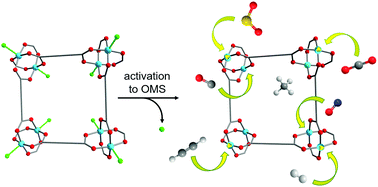Coordinatively unsaturated metal sites (open metal sites) in metal–organic frameworks: design and applications†
Abstract
Metal–organic frameworks (MOFs) can contain open metal sites (OMS) or coordinatively unsaturated sites (CUS) or open coordination sites (OCS) when vacant Lewis acid sites on the metal ions or cluster nodes have been generated. This review combines for the first time all aspects of OMS in MOFs, starting from different preparation strategies over theoretical studies on the effects of OMS with host–guest interactions up to distinct OMS-MOF applications. In the experimental part the focus of this review is on MOFs with proven OMS formation which are not only invoked but are clearly verified by analytical methods.



 Please wait while we load your content...
Please wait while we load your content...